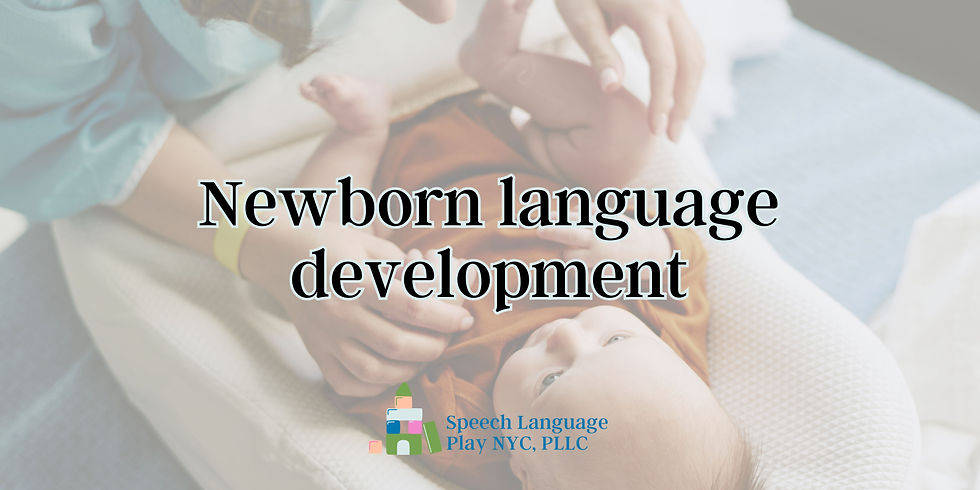Newborn Language Development
- Meghan O'Grady

- Oct 16
- 3 min read
Updated: Oct 29

I (Meghan) recently had a baby, T! Life with a newborn has been filled with so much learning, lots of frantically Googling to make sure we're doing things right, and gradually figuring out what T wants or needs as he cries and grimaces.
As a speech therapist with a passion for child development, I've especially been curious to observe my newborn's early language development and how it changes day to day. I've often shared with families that language development begins the moment a child is born (and even in utero). During the first three months, we expect a baby to do things such as:
Calm when they hear a familiar voice
Alert to sounds around them
Begin to coo or make early vocalizations
We're also working on supporting the development of pre-linguistic skills- the foundational communication skills that come before verbal communication. These include:
Joint Attention- Attending to the same object or event as another person, such as looking at a toy and then glancing toward an adult to see if they're also looking.
Eye Contact- This looks different for every child and can depend on neurodevelopmental factors. For many babies, eye contact is an early way of connecting and showing shared interest.
Cooing and Babbling- Early vocalizations that mark the start of expressive communication. Cooing involves vowel-like sounds made when babies are content, while babbling includes consonant-vowel combinations like "baba" or "mama."
Turn-taking- Even before words, babies learn that communication is a back-and-forth exchange. When a baby coos and a parent responds, either by cooing back or talking to the baby, they're learning the rhythm of conversation.
Imitation- Babies learn by copying the sounds, facial expressions, and actions of the people around them.
Gestures- Non-verbal ways of communicating, such as reaching, waving, or pointing, which lay the groundwork for spoken language.
As a new parent, it's been fascinating to see these early milestones unfold in real time. I've also found ways to intentionally incorporate language-enriching interactions into my daily routines with T. Here are a few examples from our first month together:
Daily Activities that are Language Enriching
Talking to him while feeding
(Pre-linguistic Skills: Cooing, Turn-Taking, Eye Contact)
In the early days, latching was hard for T. We worked with a lactation consultant and used short, timed sessions to practice. When he became upset, we'd pause to soothe him with a pacifier and talk softly to him: "That was hard. You did your best. We've got you." As I soothed him with my words, he'd look towards me and make cooing noises, all with a grimace on his face, which I interpreted as him telling me, "This is hard, but I love hearing your voice." :)
Using parentese- that high-pitched, sing-song tone with exaggerated vowels- also seemed to calm him. Our voices became a signal of safety and comfort. Now that nursing is easier, I often talk to him about our day. In the morning, I'll share our plans; in the afternoon/evening, I'll recap our day. Around week four, I noticed that T started gazing up at me while I talked- a tiny but magical sign of early engagement and connection.
Diaper changes
(Pre-linguistic Skills: Turn-taking, Imitation, Eye Contact, Gestures, Joint Attention, Cooing)
The changing table is somehow one of T's favorite places. He absolutely loves the simple mobile above him (a dog, cat, ball, and ring from Ikea). Around week three, he began cooing at it, and I started imitating his sounds or responding verbally (e.g., Yea, you love seeing your cat and dog.) During diaper changes, I narrate what we're doing and pair my words with facial expressions and gestures. "Time to change your diaper. Let's go say hi to your dog and cat. They love you! Hi doggies, hi kitty! Time to say bye-bye- we'll see you later!" These small exchanges are full of early communication practice- shared attention, imitation, turn- taking and social reciprocity.
Play mat and tummy time
(Pre-linguistic Skills- Joint Attention, Eye Contact, Imitation, Turn-taking)
Our play mat sessions are short for now, just a few minutes between naps and feeds, but even these tiny windows are meaningful to newborn language development. We look at high contrast black- and- white images, crinkle books, and a mirror. By week four or five, T began shifting his gaze toward the toys or to me as I talked to him. I imitate his coos and respond to his sounds as if we're having a conversation- an early foundation for turn-taking and social communication.
Newborns truly change day to day, and it's incredible to see how quickly their communication evolves. I'm looking forward to continuing to observe T's language milestones and seeing how our interactions grow with him.
Stay tuned for future posts on early language development, and in the meantime, check out our previous blog on early childhood language development!




Comments